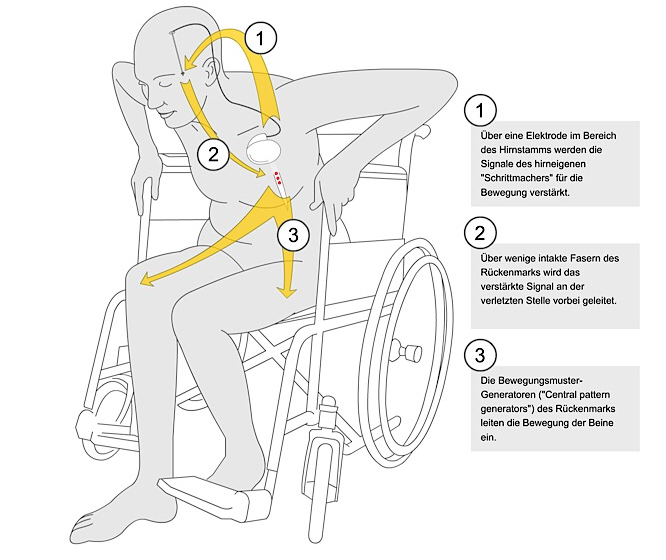DBS Study
Deep Brain Stimulation in Patients with Incomplete Spinal Cord Injury for Improvement of Gait (DBS-SCI)
In most cases of spinal cord injury (SCI), the spinal cord is not entirely destroyed while some parts remain intact to allow some functional recovery. Furthermore, the spinal cord can regenerate to some extent during the early phase after the trauma and grow new connections around the injured area. In the early phase after a trauma, the spinal cord has to be appropriately stimulated for best recovery and enabling the patient to gain functional recovery albeit limited neural repair. Rehabilitation so far is the most important and effective treatment in the early phase after spinal cord injury.
The ability to stand and walk is one of the very much desired functional outcomes after SCI.
The pattern of walking is very complex and in healthy subjects to some extent almost „automatically“ performed by a complex interaction (walking pattern generators) between the brain and the spinal cord. Following injury walking pattern generators of the brain remain intact in patients with spinal cord injury. The injury located between the brain and spinal pattern generators challenges the complex control of walking.
In experiments with animals it was possible to increase the signal from the „brain walking pattern generators“ to the spinal pattern generators by implanting a stimulation electrode in the brain. Thus, the stimulation of the brain centers allowed for activating lower limb movements following incomplete SCI. In preclinical studies paraplegic animals could regain voluntary walking ability following the stimulation.
Aim of the study is to evaluate this treatment option in men.
Publications:
- Hofer AS, Stieglitz LH, Bolliger M, Filli F, Cathomen A, Willi R, Lerch I, Krüsi I, Giagiozis M, Meyer C, Schubert M, Hubli M, Kessler TM, Demkó L, Baumann CR, Imbach L, Oertel MF, Prusse A, Kiseleva A, Regli L, Schwab ME, Curt A, Cuneiform nucleus stimulation can assist gait training to promote locomotor recovery in individuals with incomplete tetraplegia. Ann Neurol. 2025 Sep.DOI: 10.1002/ana.78026
- Stieglitz LH, Hofer AS, Bolliger M, Oertel MF, Filli L, Willi R, Cathomen A, Meyer C, Schubert M, Hubli M, Kessler TM, Baumann CR, Imbach L, Krüsi I, Prusse A, Schwab ME, Regli L, Curt A. Deep brain stimulation for locomotion in incomplete human spinal cord injury (DBS-SCI): protocol of a prospective one-armed multi-Center study. BMJ Open. 2021 Sep 30;11(9): e047670. DOI: 10.1136/bmjopen-2020-047670
For further information:
- Flyer E (PDF, 445 KB) / D (PDF, 446 KB)
- ClinicalTrials.gov: https://clinicaltrials.gov/ct2/show/NCT03053791
- Email: dbs-sci@balgrist.ch
